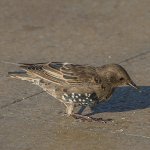Aladdin
Well-known member

Dear members and bird watchers
I was in Liverpool in August 2018 to do 6 days of bird watching with the RSPB Liverpool Group. I had a fantastic time with some very friendly people.
I spotted this Common Starling at Manchester International Airport.
I´m I right when I say that the first picture is a male in ALMOST winter plumage, black bill and not much colour in the plumage
I have put down the second picture as a Juvenile going into adult plumage, is this correct?
And one question, is there any difference between a immature and a juvenile. I know that the gulls are immature for a few years with different plumages for every year. But what about the Common Starling?
Kind regards
Aladdin
I was in Liverpool in August 2018 to do 6 days of bird watching with the RSPB Liverpool Group. I had a fantastic time with some very friendly people.
I spotted this Common Starling at Manchester International Airport.
I´m I right when I say that the first picture is a male in ALMOST winter plumage, black bill and not much colour in the plumage
I have put down the second picture as a Juvenile going into adult plumage, is this correct?
And one question, is there any difference between a immature and a juvenile. I know that the gulls are immature for a few years with different plumages for every year. But what about the Common Starling?
Kind regards
Aladdin






